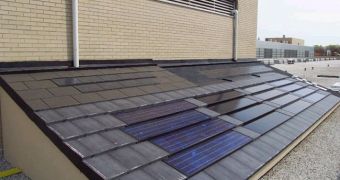Harvesting solar energy is a clever way to make use of a clean and renewable fuel. You don't need to dig the ground for it, there are no pipes and powerplants, and best of all, it's ecological. Using the roof to produce electricity is a good idea, but many people don't want to use the inaesthetical and cumbersome solar panels.
The National Institute of Standards and Technology has been testing various forms of photovoltaic roofing products for the past year on roofs in Maryland to calibrate their output. Photovoltaic shingles (or tiles, or slates) will do the same job and still look like a roof.
Roof shingles are a roof covering consisting of individual overlapping elements, usually flat rectangular shapes that are laid in rows without the side edges overlapping. Using a double layer makes them waterproof and if the ability to harness the Sun's energy is added, they really look like a good idea.
"Shingles are just getting started-most of the market is still roof-mounted applications," cautioned Paul Maycock, president of Photovoltaic Energy Systems Inc. in Williamsburg, VA. Unfortunately, existent solar shingles are not too efficient and can't convert more than 10 percent of the solar energy into electricity of heat and they don't exactly come cheap, either.
"You look for a south-facing roof that is not shadowed by trees or by another building, and you cover it as best you can," Maycock said. "With shingles, you are stuck with the roof you have, and with the less-desirable results that it gives you. So in many cases you just don't do it."
As with almost all new technologies promising us a better life, the solar shingles come with a hefty price tag, which makes them inaccessible for most people and hinder further research and improvements and end up being affordable only to the richest people.

 14 DAY TRIAL //
14 DAY TRIAL //